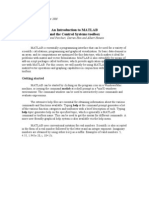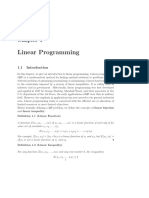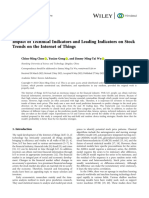0 ratings0% found this document useful (0 votes)
134 viewsPython Map
The map() function applies a given function to each item of an iterable (like a list or tuple) and returns a list of the results. It takes a function and one or more iterables as parameters. The function is applied to corresponding items from all iterables, and map() returns a map object containing the results. This map object can be converted to a list, set, or other data type. Examples demonstrate using map() to square numbers in a tuple using a defined function or lambda, and to add corresponding items from two lists using a lambda.
Uploaded by
jeeshithaCopyright
© © All Rights Reserved
Available Formats
Download as DOCX, PDF, TXT or read online on Scribd
0 ratings0% found this document useful (0 votes)
134 viewsPython Map
The map() function applies a given function to each item of an iterable (like a list or tuple) and returns a list of the results. It takes a function and one or more iterables as parameters. The function is applied to corresponding items from all iterables, and map() returns a map object containing the results. This map object can be converted to a list, set, or other data type. Examples demonstrate using map() to square numbers in a tuple using a defined function or lambda, and to add corresponding items from two lists using a lambda.
Uploaded by
jeeshithaCopyright
© © All Rights Reserved
Available Formats
Download as DOCX, PDF, TXT or read online on Scribd
You are on page 1/ 3
Python map()
____________________________________________
The map() function applies a given function to each item of an
iterable (list, tuple etc.) and returns a list of the results.
The syntax of map() is:
map(function, iterable, ...)
map() Parameter
function - map() passes each item of the iterable to this function.
iterable -iterable which is to be mapped
You can pass more than one iterable to the map() function.
Return Value from map()
The map() function applies a given to function to each item of an
iterable and returns a list of the results.
The returned value from map() (map object) then can be passed
to functions like list() (to create a list), set() (to create a set) and
so on.
Example 1: How map() works?
def calculateSquare(n):
return n*n
numbers = (1, 2, 3, 4)
result = map(calculateSquare, numbers)
print(result)
# converting map object to set
numbersSquare = set(result)
print(numbersSquare)
When you run the program, the output will be:
<map object at 0x7f722da129e8>
{16, 1, 4, 9}
In the above example, each item of the tuple is squared.
Since map() expects a function to be passed in, lambda functions
are commonly used while working with map() functions.
A lambda function is a function without a name. Visit this page to
learn more about Python lambda Function.
Example 2: How to use lambda function with map()?
numbers = (1, 2, 3, 4)
result = map(lambda x: x*x, numbers)
print(result)
# converting map object to set
numbersSquare = set(result)
print(numbersSquare)
When you run the program, the output will be:
<map 0x7fafc21ccb00>
{16, 1, 4, 9}
There is no difference in functionalities of this example and Example 1.
Example 3: Passing Multiple Iterators to map() Using Lambda
In this example, corresponding items of two lists are added.
Program:
num1 = [4, 5, 6]
num2 = [5, 6, 7]
result = map(lambda n1, n2: n1+n2, num1, num2)
print(list(result))
When you run the program, the output will be:
[9, 11, 13]
You might also like
- The Map Interface (The Java™ Tutorials Collections Interfaces)No ratings yetThe Map Interface (The Java™ Tutorials Collections Interfaces)6 pages
- Mapreduce: Theory and Implementation: Cse 490H - Intro To Distributed Computing, Modified by George LeeNo ratings yetMapreduce: Theory and Implementation: Cse 490H - Intro To Distributed Computing, Modified by George Lee33 pages
- PSC-UNIT1-3-Higher Order Functions in PythonNo ratings yetPSC-UNIT1-3-Higher Order Functions in Python13 pages
- Ba 340: Data Analytics: Pipes/Apply in RNo ratings yetBa 340: Data Analytics: Pipes/Apply in R19 pages
- Plotting in MATLAB: Electromagnetic Fields and WavesNo ratings yetPlotting in MATLAB: Electromagnetic Fields and Waves10 pages
- Functional Programming in Python Chapter 2No ratings yetFunctional Programming in Python Chapter 24 pages
- First Part of This Tutorial On The Java 8 Stream Api: Map Maptoint Maptolong MaptodoubleNo ratings yetFirst Part of This Tutorial On The Java 8 Stream Api: Map Maptoint Maptolong Maptodouble21 pages
- Building Java Programs: Functional Programming With Java 8No ratings yetBuilding Java Programs: Functional Programming With Java 828 pages
- FALL WIN SEM (2023-24) CSE0106 ETH AP2023243000534 Reference Material I 04-Nov-2023 Module4No ratings yetFALL WIN SEM (2023-24) CSE0106 ETH AP2023243000534 Reference Material I 04-Nov-2023 Module4102 pages
- MATLAB MATLAB Lab Manual Numerical Methods and Matlab80% (5)MATLAB MATLAB Lab Manual Numerical Methods and Matlab14 pages
- Graphs with MATLAB (Taken from "MATLAB for Beginners: A Gentle Approach")From EverandGraphs with MATLAB (Taken from "MATLAB for Beginners: A Gentle Approach")4/5 (2)
- A Data Locality For Z-Curve Cache Oblivious Matrix Multiplication AlgorithmsNo ratings yetA Data Locality For Z-Curve Cache Oblivious Matrix Multiplication Algorithms5 pages
- Laecture 2:linear Data Structure:ArraysNo ratings yetLaecture 2:linear Data Structure:Arrays22 pages
- Continuum Mechanics, Applied Mathematics and Scientific Computing: Godunov's LegacyNo ratings yetContinuum Mechanics, Applied Mathematics and Scientific Computing: Godunov's Legacy378 pages
- New Extended LMI Characterization For State Feedback Control of Continuous-Time Uncertain Linear SystemsNo ratings yetNew Extended LMI Characterization For State Feedback Control of Continuous-Time Uncertain Linear Systems6 pages
- Greek Long-Term Energy Consumption Prediction Using Artificial Neural NetworksNo ratings yetGreek Long-Term Energy Consumption Prediction Using Artificial Neural Networks7 pages
- Introduction To Repairable System ModelingNo ratings yetIntroduction To Repairable System Modeling27 pages
- Deriving Simpsons Rule Using Newton InterpolationNo ratings yetDeriving Simpsons Rule Using Newton Interpolation4 pages
- 04of22 - Superposition-Inspired Reinforcement Learning and Quantum Reinforcement LearningNo ratings yet04of22 - Superposition-Inspired Reinforcement Learning and Quantum Reinforcement Learning26 pages
- 21CS15IT PROBLEM SOLVING AND PYTHON PROGRAMMING QUESTIONS AND ANSWERSNo ratings yet21CS15IT PROBLEM SOLVING AND PYTHON PROGRAMMING QUESTIONS AND ANSWERS6 pages
- Experiment 2: Aim: To Implement and Analyze Merge Sort Algorithm. TheoryNo ratings yetExperiment 2: Aim: To Implement and Analyze Merge Sort Algorithm. Theory5 pages
- Research Article Impact of Technical Indicators and Leading Indicators On Stock Trends On The Internet of ThingsNo ratings yetResearch Article Impact of Technical Indicators and Leading Indicators On Stock Trends On The Internet of Things15 pages
- Energy-Constrained Private and Quantum Capacities of Quantum ChannelsNo ratings yetEnergy-Constrained Private and Quantum Capacities of Quantum Channels41 pages
- AyushiTiwari2214506380Enhancing Financial SecurityNo ratings yetAyushiTiwari2214506380Enhancing Financial Security10 pages
- Lesson 4 8 Answer Key AP Precalculus Math Medic Db114f9b6fNo ratings yetLesson 4 8 Answer Key AP Precalculus Math Medic Db114f9b6f3 pages

























































































